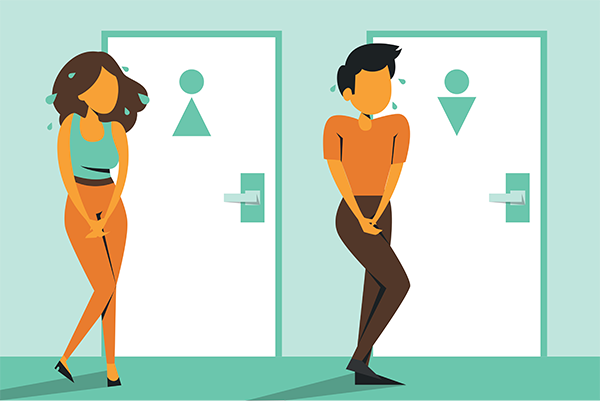
When our internal plumbing functions properly, many of us don’t think twice about our bladders. However, the urologic system becomes a topic of interest and concern when it doesn’t behave as it should.
Sometimes, individuals may experience symptoms that could be indicative of pelvic floor dysfunction. These symptoms may include urinary frequency (a constant feeling of having to urinate, even if one has recently voided), urinary urgency (a strong and sudden urge to urinate, without ample warning time), urinary incontinence (involuntary loss of urine), urinary hesitancy (difficulty initiating urine flow while trying to void), and pain or a burning sensation while urinating.
No one should have to live with any of the aforementioned symptoms. It is important to keep in mind what is considered “normal,” and that includes voiding 6-8x/day, 0-1x/night, and a feeling of complete emptying of the bladder after urinating. In addition, one should never feel the need to strain or experience pain while urinating.
Pelvic Floor Therapy Works for Urge Incontinence Treatment and More
The pelvic floor muscles play an important role in elimination of urine (and feces). The pelvic floor muscles contract in order to “hold it in”, i.e. to maintain urinary continence, and they relax in order to allow for complete emptying of the bladder. If the pelvic floor muscles become tight (ex. due to prolonged sitting, stress, history of infection, or previous trauma, to name a few), the muscles may not be able to fully relax to enable complete emptying of the bladder. This is considered overactivity of the pelvic floor muscles.
A helpful analogy to understand this concept is to imagine that the pelvic floor muscles are like a fist squeezing around a hose. The hose represents the urethra, the opening through which urine exits the body. If the fist remains stuck and is unable to open around the hose, it will be difficult for water to pass from one end of the hose to the other end. So too with the pelvic floor muscles; if the pelvic floor muscle “fist” remains clenched tightly around the urethra, it will interfere with elimination of urine through the urethra. This can result in many of the aforementioned symptoms.
As opposed to overactivity and tightness, the pelvic floor muscles may also demonstrate underactivity or weakness. Weakness of the pelvic floor muscles is often associated with urinary incontinence, or involuntary loss of urine. Weakness of the pelvic floor muscles may result from pregnancy, labor and delivery, previous surgeries, or aging related hormonal changes.
The Benefits of Pelvic Floor Therapy for Bladder Dysfunction
Individuals experiencing bladder symptoms stand to benefit from pelvic floor physical therapy. Pelvic floor physical therapy is an excellent and effective intervention to help stretch the tight pelvic floor muscles and/or strengthen weak muscles. Pelvic floor physical therapy also includes trigger point release of any “muscle knots” which may be present in the pelvic floor, as well as myofascial release and connective tissue mobilization of tight structures, including tendons, ligaments, and nerves. In addition, appropriate home exercises are taught which will enable you to maintain the benefits gained between sessions, and they will allow you to progress your healing process.
Pelvic Floor Physical Therapy for Bladder Dysfunction in New York City
Individuals who experience any of the aforementioned bladder symptoms may significantly benefit from pelvic floor physical therapy. Please contact us at Revitalize Physical Therapy to learn more about how our services can benefit you.


